Average Precision¶
Module Interface¶
- class torchmetrics.AveragePrecision(**kwargs)[source]¶
Compute the average precision (AP) score.
The AP score summarizes a precision-recall curve as an weighted mean of precisions at each threshold, with the difference in recall from the previous threshold as weight:
\[AP = \sum_{n} (R_n - R_{n-1}) P_n\]where \(P_n, R_n\) is the respective precision and recall at threshold index \(n\). This value is equivalent to the area under the precision-recall curve (AUPRC).
This function is a simple wrapper to get the task specific versions of this metric, which is done by setting the
taskargument to either'binary','multiclass'or'multilabel'. See the documentation ofBinaryAveragePrecision,MulticlassAveragePrecisionandMultilabelAveragePrecisionfor the specific details of each argument influence and examples.- Legacy Example:
>>> from torch import tensor >>> pred = tensor([0, 0.1, 0.8, 0.4]) >>> target = tensor([0, 1, 1, 1]) >>> average_precision = AveragePrecision(task="binary") >>> average_precision(pred, target) tensor(1.)
>>> pred = tensor([[0.75, 0.05, 0.05, 0.05, 0.05], ... [0.05, 0.75, 0.05, 0.05, 0.05], ... [0.05, 0.05, 0.75, 0.05, 0.05], ... [0.05, 0.05, 0.05, 0.75, 0.05]]) >>> target = tensor([0, 1, 3, 2]) >>> average_precision = AveragePrecision(task="multiclass", num_classes=5, average=None) >>> average_precision(pred, target) tensor([1.0000, 1.0000, 0.2500, 0.2500, nan])
BinaryAveragePrecision¶
- class torchmetrics.classification.BinaryAveragePrecision(thresholds=None, ignore_index=None, validate_args=True, normalization='sigmoid', **kwargs)[source]¶
Compute the average precision (AP) score for binary tasks.
The AP score summarizes a precision-recall curve as an weighted mean of precisions at each threshold, with the difference in recall from the previous threshold as weight:
\[AP = \sum_{n} (R_n - R_{n-1}) P_n\]where \(P_n, R_n\) is the respective precision and recall at threshold index \(n\). This value is equivalent to the area under the precision-recall curve (AUPRC).
As input to
forwardandupdatethe metric accepts the following input:preds(Tensor): A float tensor of shape(N, ...)containing probabilities or logits for each observation. If preds has values outside [0,1] range we consider the input to be logits and will auto apply sigmoid per element.target(Tensor): An int tensor of shape(N, ...)containing ground truth labels, and therefore only contain {0,1} values (except if ignore_index is specified). The value 1 always encodes the positive class.
As output to
forwardandcomputethe metric returns the following output:bap(Tensor): A single scalar with the average precision score
Additional dimension
...will be flattened into the batch dimension.The implementation both supports calculating the metric in a non-binned but accurate version and a binned version that is less accurate but more memory efficient. Setting the thresholds argument to None will activate the non-binned version that uses memory of size \(\mathcal{O}(n_{samples})\) whereas setting the thresholds argument to either an integer, list or a 1d tensor will use a binned version that uses memory of size \(\mathcal{O}(n_{thresholds})\) (constant memory).
- Parameters:
thresholds¶ (
Union[int,list[float],Tensor,None]) –Can be one of:
If set to None, will use a non-binned approach where thresholds are dynamically calculated from all the data. Most accurate but also most memory consuming approach.
If set to an int (larger than 1), will use that number of thresholds linearly spaced from 0 to 1 as bins for the calculation.
If set to an list of floats, will use the indicated thresholds in the list as bins for the calculation
If set to an 1d tensor of floats, will use the indicated thresholds in the tensor as bins for the calculation.
validate_args¶ (
bool) – bool indicating if input arguments and tensors should be validated for correctness. Set toFalsefor faster computations.kwargs¶ (
Any) – Additional keyword arguments, see Advanced metric settings for more info.
Example
>>> from torch import tensor >>> from torchmetrics.classification import BinaryAveragePrecision >>> preds = tensor([0, 0.5, 0.7, 0.8]) >>> target = tensor([0, 1, 1, 0]) >>> metric = BinaryAveragePrecision(thresholds=None) >>> metric(preds, target) tensor(0.5833) >>> bap = BinaryAveragePrecision(thresholds=5) >>> bap(preds, target) tensor(0.6667)
- plot(val=None, ax=None)[source]¶
Plot a single or multiple values from the metric.
- Parameters:
val¶ (
Union[Tensor,Sequence[Tensor],None]) – Either a single result from calling metric.forward or metric.compute or a list of these results. If no value is provided, will automatically call metric.compute and plot that result.ax¶ (
Optional[Axes]) – An matplotlib axis object. If provided will add plot to that axis
- Return type:
- Returns:
Figure and Axes object
- Raises:
ModuleNotFoundError – If matplotlib is not installed
>>> # Example plotting a single >>> import torch >>> from torchmetrics.classification import BinaryAveragePrecision >>> metric = BinaryAveragePrecision() >>> metric.update(torch.rand(20,), torch.randint(2, (20,))) >>> fig_, ax_ = metric.plot()
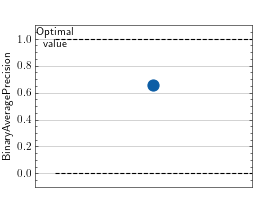
>>> # Example plotting multiple values >>> import torch >>> from torchmetrics.classification import BinaryAveragePrecision >>> metric = BinaryAveragePrecision() >>> values = [ ] >>> for _ in range(10): ... values.append(metric(torch.rand(20,), torch.randint(2, (20,)))) >>> fig_, ax_ = metric.plot(values)
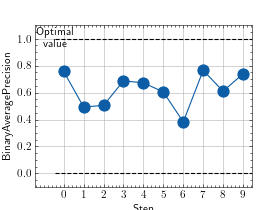
MulticlassAveragePrecision¶
- class torchmetrics.classification.MulticlassAveragePrecision(num_classes, average='macro', thresholds=None, ignore_index=None, validate_args=True, **kwargs)[source]¶
Compute the average precision (AP) score for multiclass tasks.
The AP score summarizes a precision-recall curve as an weighted mean of precisions at each threshold, with the difference in recall from the previous threshold as weight:
\[AP = \sum_{n} (R_n - R_{n-1}) P_n\]where \(P_n, R_n\) is the respective precision and recall at threshold index \(n\). This value is equivalent to the area under the precision-recall curve (AUPRC).
For multiclass the metric is calculated by iteratively treating each class as the positive class and all other classes as the negative, which is referred to as the one-vs-rest approach. One-vs-one is currently not supported by this metric. By default the reported metric is then the average over all classes, but this behavior can be changed by setting the
averageargument.As input to
forwardandupdatethe metric accepts the following input:preds(Tensor): A float tensor of shape(N, C, ...)containing probabilities or logits for each observation. If preds has values outside [0,1] range we consider the input to be logits and will auto apply softmax per sample.target(Tensor): An int tensor of shape(N, ...)containing ground truth labels, and therefore only contain values in the [0, n_classes-1] range (except if ignore_index is specified).
As output to
forwardandcomputethe metric returns the following output:mcap(Tensor): If average=None|”none” then a 1d tensor of shape (n_classes, ) will be returned with AP score per class. If average=”macro”|”weighted” then a single scalar is returned.
Additional dimension
...will be flattened into the batch dimension.The implementation both supports calculating the metric in a non-binned but accurate version and a binned version that is less accurate but more memory efficient. Setting the thresholds argument to None will activate the non-binned version that uses memory of size \(\mathcal{O}(n_{samples})\) whereas setting the thresholds argument to either an integer, list or a 1d tensor will use a binned version that uses memory of size \(\mathcal{O}(n_{thresholds} \times n_{classes})\) (constant memory).
- Parameters:
num_classes¶ (
int) – Integer specifying the number of classesaverage¶ (
Optional[Literal['macro','weighted','none']]) –Defines the reduction that is applied over classes. Should be one of the following:
macro: Calculate score for each class and average themweighted: calculates score for each class and computes weighted average using their support"none"orNone: calculates score for each class and applies no reduction
thresholds¶ (
Union[int,list[float],Tensor,None]) –Can be one of:
If set to None, will use a non-binned approach where thresholds are dynamically calculated from all the data. Most accurate but also most memory consuming approach.
If set to an int (larger than 1), will use that number of thresholds linearly spaced from 0 to 1 as bins for the calculation.
If set to an list of floats, will use the indicated thresholds in the list as bins for the calculation
If set to an 1d tensor of floats, will use the indicated thresholds in the tensor as bins for the calculation.
validate_args¶ (
bool) – bool indicating if input arguments and tensors should be validated for correctness. Set toFalsefor faster computations.kwargs¶ (
Any) – Additional keyword arguments, see Advanced metric settings for more info.
Example
>>> from torch import tensor >>> from torchmetrics.classification import MulticlassAveragePrecision >>> preds = tensor([[0.75, 0.05, 0.05, 0.05, 0.05], ... [0.05, 0.75, 0.05, 0.05, 0.05], ... [0.05, 0.05, 0.75, 0.05, 0.05], ... [0.05, 0.05, 0.05, 0.75, 0.05]]) >>> target = tensor([0, 1, 3, 2]) >>> metric = MulticlassAveragePrecision(num_classes=5, average="macro", thresholds=None) >>> metric(preds, target) tensor(0.6250) >>> mcap = MulticlassAveragePrecision(num_classes=5, average=None, thresholds=None) >>> mcap(preds, target) tensor([1.0000, 1.0000, 0.2500, 0.2500, nan]) >>> mcap = MulticlassAveragePrecision(num_classes=5, average="macro", thresholds=5) >>> mcap(preds, target) tensor(0.5000) >>> mcap = MulticlassAveragePrecision(num_classes=5, average=None, thresholds=5) >>> mcap(preds, target) tensor([1.0000, 1.0000, 0.2500, 0.2500, -0.0000])
- plot(val=None, ax=None)[source]¶
Plot a single or multiple values from the metric.
- Parameters:
val¶ (
Union[Tensor,Sequence[Tensor],None]) – Either a single result from calling metric.forward or metric.compute or a list of these results. If no value is provided, will automatically call metric.compute and plot that result.ax¶ (
Optional[Axes]) – An matplotlib axis object. If provided will add plot to that axis
- Return type:
- Returns:
Figure and Axes object
- Raises:
ModuleNotFoundError – If matplotlib is not installed
>>> # Example plotting a single >>> import torch >>> from torchmetrics.classification import MulticlassAveragePrecision >>> metric = MulticlassAveragePrecision(num_classes=3) >>> metric.update(torch.randn(20, 3), torch.randint(3,(20,))) >>> fig_, ax_ = metric.plot()
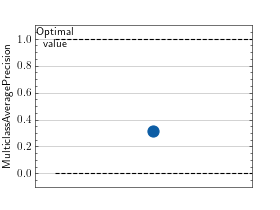
>>> # Example plotting multiple values >>> import torch >>> from torchmetrics.classification import MulticlassAveragePrecision >>> metric = MulticlassAveragePrecision(num_classes=3) >>> values = [ ] >>> for _ in range(10): ... values.append(metric(torch.randn(20, 3), torch.randint(3, (20,)))) >>> fig_, ax_ = metric.plot(values)
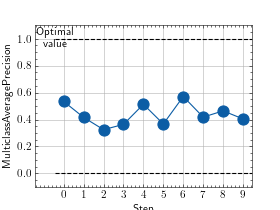
MultilabelAveragePrecision¶
- class torchmetrics.classification.MultilabelAveragePrecision(num_labels, average='macro', thresholds=None, ignore_index=None, validate_args=True, **kwargs)[source]¶
Compute the average precision (AP) score for multilabel tasks.
The AP score summarizes a precision-recall curve as an weighted mean of precisions at each threshold, with the difference in recall from the previous threshold as weight:
\[AP = \sum_{n} (R_n - R_{n-1}) P_n\]where \(P_n, R_n\) is the respective precision and recall at threshold index \(n\). This value is equivalent to the area under the precision-recall curve (AUPRC).
As input to
forwardandupdatethe metric accepts the following input:preds(Tensor): A float tensor of shape(N, C, ...)containing probabilities or logits for each observation. If preds has values outside [0,1] range we consider the input to be logits and will auto apply sigmoid per element.target(Tensor): An int tensor of shape(N, C, ...)containing ground truth labels, and therefore only contain {0,1} values (except if ignore_index is specified).
As output to
forwardandcomputethe metric returns the following output:mlap(Tensor): If average=None|”none” then a 1d tensor of shape (n_classes, ) will be returned with AP score per class. If average=”micro|macro”|”weighted” then a single scalar is returned.
Additional dimension
...will be flattened into the batch dimension.The implementation both supports calculating the metric in a non-binned but accurate version and a binned version that is less accurate but more memory efficient. Setting the thresholds argument to None will activate the non-binned version that uses memory of size \(\mathcal{O}(n_{samples})\) whereas setting the thresholds argument to either an integer, list or a 1d tensor will use a binned version that uses memory of size \(\mathcal{O}(n_{thresholds} \times n_{labels})\) (constant memory).
- Parameters:
average¶ (
Optional[Literal['micro','macro','weighted','none']]) –Defines the reduction that is applied over labels. Should be one of the following:
micro: Sum score over all labelsmacro: Calculate score for each label and average themweighted: calculates score for each label and computes weighted average using their support"none"orNone: calculates score for each label and applies no reduction
thresholds¶ (
Union[int,list[float],Tensor,None]) –Can be one of:
If set to None, will use a non-binned approach where thresholds are dynamically calculated from all the data. Most accurate but also most memory consuming approach.
If set to an int (larger than 1), will use that number of thresholds linearly spaced from 0 to 1 as bins for the calculation.
If set to an list of floats, will use the indicated thresholds in the list as bins for the calculation
If set to an 1d tensor of floats, will use the indicated thresholds in the tensor as bins for the calculation.
validate_args¶ (
bool) – bool indicating if input arguments and tensors should be validated for correctness. Set toFalsefor faster computations.kwargs¶ (
Any) – Additional keyword arguments, see Advanced metric settings for more info.
Example
>>> from torch import tensor >>> from torchmetrics.classification import MultilabelAveragePrecision >>> preds = tensor([[0.75, 0.05, 0.35], ... [0.45, 0.75, 0.05], ... [0.05, 0.55, 0.75], ... [0.05, 0.65, 0.05]]) >>> target = tensor([[1, 0, 1], ... [0, 0, 0], ... [0, 1, 1], ... [1, 1, 1]]) >>> metric = MultilabelAveragePrecision(num_labels=3, average="macro", thresholds=None) >>> metric(preds, target) tensor(0.7500) >>> mlap = MultilabelAveragePrecision(num_labels=3, average=None, thresholds=None) >>> mlap(preds, target) tensor([0.7500, 0.5833, 0.9167]) >>> mlap = MultilabelAveragePrecision(num_labels=3, average="macro", thresholds=5) >>> mlap(preds, target) tensor(0.7778) >>> mlap = MultilabelAveragePrecision(num_labels=3, average=None, thresholds=5) >>> mlap(preds, target) tensor([0.7500, 0.6667, 0.9167])
- plot(val=None, ax=None)[source]¶
Plot a single or multiple values from the metric.
- Parameters:
val¶ (
Union[Tensor,Sequence[Tensor],None]) – Either a single result from calling metric.forward or metric.compute or a list of these results. If no value is provided, will automatically call metric.compute and plot that result.ax¶ (
Optional[Axes]) – An matplotlib axis object. If provided will add plot to that axis
- Return type:
- Returns:
Figure and Axes object
- Raises:
ModuleNotFoundError – If matplotlib is not installed
>>> # Example plotting a single >>> import torch >>> from torchmetrics.classification import MultilabelAveragePrecision >>> metric = MultilabelAveragePrecision(num_labels=3) >>> metric.update(torch.rand(20,3), torch.randint(2, (20,3))) >>> fig_, ax_ = metric.plot()
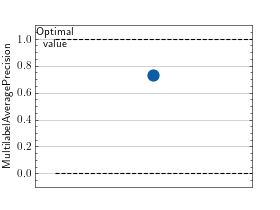
>>> # Example plotting multiple values >>> import torch >>> from torchmetrics.classification import MultilabelAveragePrecision >>> metric = MultilabelAveragePrecision(num_labels=3) >>> values = [ ] >>> for _ in range(10): ... values.append(metric(torch.rand(20,3), torch.randint(2, (20,3)))) >>> fig_, ax_ = metric.plot(values)
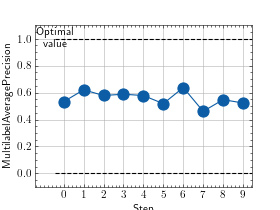
Functional Interface¶
- torchmetrics.functional.average_precision(preds, target, task, thresholds=None, num_classes=None, num_labels=None, average='macro', ignore_index=None, validate_args=True)[source]¶
Compute the average precision (AP) score.
The AP score summarizes a precision-recall curve as an weighted mean of precisions at each threshold, with the difference in recall from the previous threshold as weight: :rtype:
Optional[Tensor]\[AP = \sum{n} (R_n - R_{n-1}) P_n\]where \(P_n, R_n\) is the respective precision and recall at threshold index \(n\). This value is equivalent to the area under the precision-recall curve (AUPRC).
This function is a simple wrapper to get the task specific versions of this metric, which is done by setting the
taskargument to either'binary','multiclass'or'multilabel'. See the documentation ofbinary_average_precision(),multiclass_average_precision()andmultilabel_average_precision()for the specific details of each argument influence and examples.- Legacy Example:
>>> from torchmetrics.functional.classification import average_precision >>> pred = torch.tensor([0.0, 1.0, 2.0, 3.0]) >>> target = torch.tensor([0, 1, 1, 1]) >>> average_precision(pred, target, task="binary") tensor(1.)
>>> pred = torch.tensor([[0.75, 0.05, 0.05, 0.05, 0.05], ... [0.05, 0.75, 0.05, 0.05, 0.05], ... [0.05, 0.05, 0.75, 0.05, 0.05], ... [0.05, 0.05, 0.05, 0.75, 0.05]]) >>> target = torch.tensor([0, 1, 3, 2]) >>> average_precision(pred, target, task="multiclass", num_classes=5, average=None) tensor([1.0000, 1.0000, 0.2500, 0.2500, nan])
binary_average_precision¶
- torchmetrics.functional.classification.binary_average_precision(preds, target, thresholds=None, ignore_index=None, validate_args=True)[source]¶
Compute the average precision (AP) score for binary tasks.
The AP score summarizes a precision-recall curve as an weighted mean of precisions at each threshold, with the difference in recall from the previous threshold as weight:
\[AP = \sum{n} (R_n - R_{n-1}) P_n\]where \(P_n, R_n\) is the respective precision and recall at threshold index \(n\). This value is equivalent to the area under the precision-recall curve (AUPRC).
Accepts the following input tensors:
preds(float tensor):(N, ...). Preds should be a tensor containing probabilities or logits for each observation. If preds has values outside [0,1] range we consider the input to be logits and will auto apply sigmoid per element.target(int tensor):(N, ...). Target should be a tensor containing ground truth labels, and therefore only contain {0,1} values (except if ignore_index is specified). The value 1 always encodes the positive class.
Additional dimension
...will be flattened into the batch dimension.The implementation both supports calculating the metric in a non-binned but accurate version and a binned version that is less accurate but more memory efficient. Setting the thresholds argument to None will activate the non-binned version that uses memory of size \(\mathcal{O}(n_{samples})\) whereas setting the thresholds argument to either an integer, list or a 1d tensor will use a binned version that uses memory of size \(\mathcal{O}(n_{thresholds})\) (constant memory).
- Parameters:
thresholds¶ (
Union[int,list[float],Tensor,None]) –Can be one of:
If set to None, will use a non-binned approach where thresholds are dynamically calculated from all the data. Most accurate but also most memory consuming approach.
If set to an int (larger than 1), will use that number of thresholds linearly spaced from 0 to 1 as bins for the calculation.
If set to an list of floats, will use the indicated thresholds in the list as bins for the calculation
If set to an 1d tensor of floats, will use the indicated thresholds in the tensor as bins for the calculation.
ignore_index¶ (
Optional[int]) – Specifies a target value that is ignored and does not contribute to the metric calculationvalidate_args¶ (
bool) – bool indicating if input arguments and tensors should be validated for correctness. Set toFalsefor faster computations.
- Return type:
- Returns:
A single scalar with the average precision score
Example
>>> from torchmetrics.functional.classification import binary_average_precision >>> preds = torch.tensor([0, 0.5, 0.7, 0.8]) >>> target = torch.tensor([0, 1, 1, 0]) >>> binary_average_precision(preds, target, thresholds=None) tensor(0.5833) >>> binary_average_precision(preds, target, thresholds=5) tensor(0.6667)
multiclass_average_precision¶
- torchmetrics.functional.classification.multiclass_average_precision(preds, target, num_classes, average='macro', thresholds=None, ignore_index=None, validate_args=True)[source]¶
Compute the average precision (AP) score for multiclass tasks.
The AP score summarizes a precision-recall curve as an weighted mean of precisions at each threshold, with the difference in recall from the previous threshold as weight:
\[AP = \sum{n} (R_n - R_{n-1}) P_n\]where \(P_n, R_n\) is the respective precision and recall at threshold index \(n\). This value is equivalent to the area under the precision-recall curve (AUPRC).
Accepts the following input tensors:
preds(float tensor):(N, C, ...). Preds should be a tensor containing probabilities or logits for each observation. If preds has values outside [0,1] range we consider the input to be logits and will auto apply softmax per sample.target(int tensor):(N, ...). Target should be a tensor containing ground truth labels, and therefore only contain values in the [0, n_classes-1] range (except if ignore_index is specified).
Additional dimension
...will be flattened into the batch dimension.The implementation both supports calculating the metric in a non-binned but accurate version and a binned version that is less accurate but more memory efficient. Setting the thresholds argument to None will activate the non-binned version that uses memory of size \(\mathcal{O}(n_{samples})\) whereas setting the thresholds argument to either an integer, list or a 1d tensor will use a binned version that uses memory of size \(\mathcal{O}(n_{thresholds} \times n_{classes})\) (constant memory).
- Parameters:
num_classes¶ (
int) – Integer specifying the number of classesaverage¶ (
Optional[Literal['macro','weighted','none']]) –Defines the reduction that is applied over classes. Should be one of the following:
macro: Calculate score for each class and average themweighted: calculates score for each class and computes weighted average using their support"none"orNone: calculates score for each class and applies no reduction
thresholds¶ (
Union[int,list[float],Tensor,None]) –Can be one of:
If set to None, will use a non-binned approach where thresholds are dynamically calculated from all the data. Most accurate but also most memory consuming approach.
If set to an int (larger than 1), will use that number of thresholds linearly spaced from 0 to 1 as bins for the calculation.
If set to an list of floats, will use the indicated thresholds in the list as bins for the calculation
If set to an 1d tensor of floats, will use the indicated thresholds in the tensor as bins for the calculation.
ignore_index¶ (
Optional[int]) – Specifies a target value that is ignored and does not contribute to the metric calculationvalidate_args¶ (
bool) – bool indicating if input arguments and tensors should be validated for correctness. Set toFalsefor faster computations.
- Return type:
- Returns:
If average=None|”none” then a 1d tensor of shape (n_classes, ) will be returned with AP score per class. If average=”macro”|”weighted” then a single scalar is returned.
Example
>>> from torchmetrics.functional.classification import multiclass_average_precision >>> preds = torch.tensor([[0.75, 0.05, 0.05, 0.05, 0.05], ... [0.05, 0.75, 0.05, 0.05, 0.05], ... [0.05, 0.05, 0.75, 0.05, 0.05], ... [0.05, 0.05, 0.05, 0.75, 0.05]]) >>> target = torch.tensor([0, 1, 3, 2]) >>> multiclass_average_precision(preds, target, num_classes=5, average="macro", thresholds=None) tensor(0.6250) >>> multiclass_average_precision(preds, target, num_classes=5, average=None, thresholds=None) tensor([1.0000, 1.0000, 0.2500, 0.2500, nan]) >>> multiclass_average_precision(preds, target, num_classes=5, average="macro", thresholds=5) tensor(0.5000) >>> multiclass_average_precision(preds, target, num_classes=5, average=None, thresholds=5) tensor([1.0000, 1.0000, 0.2500, 0.2500, -0.0000])
multilabel_average_precision¶
- torchmetrics.functional.classification.multilabel_average_precision(preds, target, num_labels, average='macro', thresholds=None, ignore_index=None, validate_args=True)[source]¶
Compute the average precision (AP) score for multilabel tasks.
The AP score summarizes a precision-recall curve as an weighted mean of precisions at each threshold, with the difference in recall from the previous threshold as weight:
\[AP = \sum{n} (R_n - R_{n-1}) P_n\]where \(P_n, R_n\) is the respective precision and recall at threshold index \(n\). This value is equivalent to the area under the precision-recall curve (AUPRC).
Accepts the following input tensors:
preds(float tensor):(N, C, ...). Preds should be a tensor containing probabilities or logits for each observation. If preds has values outside [0,1] range we consider the input to be logits and will auto apply sigmoid per element.target(int tensor):(N, C, ...). Target should be a tensor containing ground truth labels, and therefore only contain {0,1} values (except if ignore_index is specified).
Additional dimension
...will be flattened into the batch dimension.The implementation both supports calculating the metric in a non-binned but accurate version and a binned version that is less accurate but more memory efficient. Setting the thresholds argument to None will activate the non-binned version that uses memory of size \(\mathcal{O}(n_{samples})\) whereas setting the thresholds argument to either an integer, list or a 1d tensor will use a binned version that uses memory of size \(\mathcal{O}(n_{thresholds} \times n_{labels})\) (constant memory).
- Parameters:
average¶ (
Optional[Literal['micro','macro','weighted','none']]) –Defines the reduction that is applied over labels. Should be one of the following:
micro: Sum score over all labelsmacro: Calculate score for each label and average themweighted: calculates score for each label and computes weighted average using their support"none"orNone: calculates score for each label and applies no reduction
thresholds¶ (
Union[int,list[float],Tensor,None]) –Can be one of:
If set to None, will use a non-binned approach where thresholds are dynamically calculated from all the data. Most accurate but also most memory consuming approach.
If set to an int (larger than 1), will use that number of thresholds linearly spaced from 0 to 1 as bins for the calculation.
If set to an list of floats, will use the indicated thresholds in the list as bins for the calculation
If set to an 1d tensor of floats, will use the indicated thresholds in the tensor as bins for the calculation.
ignore_index¶ (
Optional[int]) – Specifies a target value that is ignored and does not contribute to the metric calculationvalidate_args¶ (
bool) – bool indicating if input arguments and tensors should be validated for correctness. Set toFalsefor faster computations.
- Return type:
- Returns:
If average=None|”none” then a 1d tensor of shape (n_classes, ) will be returned with AP score per class. If average=”micro|macro”|”weighted” then a single scalar is returned.
Example
>>> from torchmetrics.functional.classification import multilabel_average_precision >>> preds = torch.tensor([[0.75, 0.05, 0.35], ... [0.45, 0.75, 0.05], ... [0.05, 0.55, 0.75], ... [0.05, 0.65, 0.05]]) >>> target = torch.tensor([[1, 0, 1], ... [0, 0, 0], ... [0, 1, 1], ... [1, 1, 1]]) >>> multilabel_average_precision(preds, target, num_labels=3, average="macro", thresholds=None) tensor(0.7500) >>> multilabel_average_precision(preds, target, num_labels=3, average=None, thresholds=None) tensor([0.7500, 0.5833, 0.9167]) >>> multilabel_average_precision(preds, target, num_labels=3, average="macro", thresholds=5) tensor(0.7778) >>> multilabel_average_precision(preds, target, num_labels=3, average=None, thresholds=5) tensor([0.7500, 0.6667, 0.9167])
